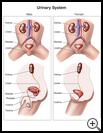
Bladder Catheter Insertion by Healthcare Provider
________________________________________________________________________
KEY POINTS
- Bladder catheters may be used to drain a full bladder, get a urine sample, allow your bladder to heal after bladder surgery, or measure urine output.
- Your healthcare provider will insert the catheter using a sterile method. The catheter may be used briefly and then removed, or it may be left in the bladder for as long as needed.
- Your healthcare provider will tell you how to care for yourself at home if you need to use a catheter and drainage bag.
________________________________________________________________________
What is a bladder catheter?
A bladder, or urinary, catheter is a thin, hollow tube inserted through the urethra into the bladder. The catheter drains urine from the bladder into a bag. Two common types of catheters are intermittent and indwelling catheters.
- An intermittent, or short-term, catheter is inserted to drain the bladder or to get a specimen. It is removed as soon as the flow of urine has stopped.
- An indwelling catheter is left in the bladder for as long as it is needed. A small inflated balloon at the tip of the catheter helps the catheter stay in the bladder.
When is it used?
Bladder catheters have many uses. For example, they may be used to:
- Get a sample of urine for lab tests
- Empty your bladder when you cannot urinate normally
- Used after surgery or while you are hospitalized with a serious illness to:
- See how well your kidneys are working by measuring how much you are urinating
- Check your water balance
- Keep your bladder empty during surgery
Catheters have many possible benefits. For example, they may:
- Give relief by emptying a full, painful bladder
- Help diagnose urinary problems, such as infection
Ask your healthcare provider about your choices for treatment and the risks.
How do I prepare for this procedure?
You don’t need to do anything to prepare for this procedure.
What happens during the procedure?
Catheters are usually inserted into the urethra while you are lying on your back. Your genital area will be cleaned with antibacterial soap. Your healthcare provider will use a sterile process to put in the catheter. You may feel some discomfort and when the catheter is inserted. Rarely, there may also be some bleeding.
A bag will be attached to the catheter outside your body to collect urine. If the catheter is placed to get a urine sample, once the urine has been collected, the catheter will be removed. If the catheter needs to stay in place for continued emptying or checking of your kidneys or water balance, then a tiny balloon (which you will not feel) will be expanded inside the bladder to hold the catheter in place. The tubing attached to the collecting bag will be taped to your leg.
What happens after the procedure?
If the catheter did not have to stay in, you may feel some burning the next few times you urinate. The burning is from irritation of the urethra by the catheter. If the catheter is left in, you may have an irritating feeling that you need to urinate, even though your urine is passing into the collecting bag continuously as your kidneys produce it.
While you have the catheter, it is important to keep the bag below your pelvic area to help the bladder drain better. This helps prevent infection by keeping the urine in the bag and tube from draining backwards into the bladder. You may have a bag that can be strapped to your leg and fits under slacks or dresses so that it does not show.
If you are going home with a catheter, make sure that you have written instructions on how to care for the catheter. Ask your healthcare provider:
- If there are activities you should avoid
- How to take care of yourself at home and when you can return to your normal activities
- What symptoms or problems you should watch for and what to do if you have them
Make sure you know when you should come back for a checkup. Keep all appointments for provider visits or tests.
What are the risks of this procedure?
Every procedure or treatment has risks. Some possible risks of this procedure include:
- The catheter may cause a bladder infection. This usually happens when the catheter has been in place for several days or weeks.
- Some tissue may be mildly damaged if you accidentally remove the catheter without deflating the balloon that keeps it in place.
Ask your healthcare provider how the risks apply to you. Be sure to discuss any other questions or concerns that you may have.

